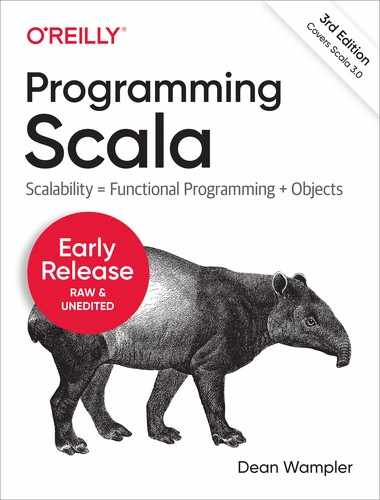Book Description
Get up to speed on Scala--the JVM, JavaScript, and natively compiled language that offers all the benefits of functional programming, a modern object model, and an advanced type system. Packed with code examples, this comprehensive book shows you how to be productive with the language and ecosystem right away. You'll learn why Scala is ideal for today's highly scalable, data-centric applications that support concurrency and distribution.
Despite the reinvigoration of Java and the introduction of Kotlin, Scala hasn't been sitting still. This third edition covers the new features in Scala 3.0, with updates throughout the book. Programming Scala is ideal for beginning to advanced developers who want a complete understanding of Scala's design philosophy and features with a thoroughly practical focus.
- Program faster with Scala's succinct and flexible syntax
- Dive into basic and advanced functional programming (FP) techniques
- Build killer big data and distributed apps, using Scala's functional combinators and tools including Akka and Spark
- Use traits for mixin composition and pattern matching for data extraction
- Learn the sophisticated type system that combines functional programming and object-oriented programming concepts
Table of Contents
- Foreword
- Preface
- Welcome to Programming Scala, Third Edition
- Welcome to Programming Scala, Second Edition
- Welcome to Programming Scala, First Edition
- Conventions Used in This Book
- Using Code Examples
- O’Reilly Safari
- How to Contact Us
- Acknowledgments for the Third Edition
- Acknowledgments for the Second Edition
- Acknowledgments for the First Edition
- 1. Zero to Sixty: Introducing Scala
- 2. Type Less, Do More
- New Scala 3 Syntax
- Semicolons
- Variable Declarations
- Ranges
- Partial Functions
- Infix Operator Notation
- Method Declarations
- Inferring Type Information
- Variadic Argument Lists
- Reserved Words
- Literal Values
- Option, Some, and None: Avoiding nulls
- Sealed Class Hierarchies and Enumerations
- Organizing Code in Files and Namespaces
- Importing Types and Their Members
- Abstract Types Versus Parameterized Types
- Recap and What’s Next
- 3. Rounding Out the Basics
- Operator Overloading?
- Allowed Characters in Identifiers
- Methods with Empty Parameter Lists
- Precedence Rules
- Enumerations and Algebraic Data Types
- Interpolated Strings
- Scala Conditional Expressions
- Conditional Operators
- Scala for Comprehensions
- Scala while Loops
- Using try, catch, and finally Clauses
- Call by Name, Call by Value
- lazy val
- Traits: Interfaces and “Mixins” in Scala
- Recap and What’s Next
- 4. Pattern Matching
- Values, Variables, and Types in Matches
- Matching on Sequences
- Matching on Tuples
- Guards in Case Clauses
- Matching on Case Classes and Enums
- Matching on Regular Expressions
- More on Type Matching
- Sealed Hierarchies and Exhaustive Matches
- Chaining Match Expressions
- Pattern Matching in Other Contexts
- Extractors
- Concluding Remarks on Pattern Matching
- Recap and What’s Next
- 5. Abstracting over Context: Type Classes and Extension Methods
- 6. Abstracting over Context: Using Clauses
- 7. Functional Programming in Scala
- What Is Functional Programming?
- Functional Programming in Scala
- Recursion
- Tail Calls and Tail-Call Optimization
- Partially Applied Functions Versus Partial Functions
- Currying and Uncurrying Functions
- Tupled and Untupled Functions
- Partial Functions vs. Functions Returning Options
- Functional Data Structures
- Traversing, Mapping, Filtering, Folding, and Reducing
- Combinators: Software’s Best Component Abstractions
- What About Making Copies?
- Recap and What’s Next
- 8. for Comprehensions in Depth
- 9. Object-Oriented Programming in Scala
- Class and Object Basics: Review
- Open vs. Closed Types
- Reference Versus Value Types
- Opaque Types and Value Classes
- Parent Types
- Constructors in Scala
- Calling Parent Class Constructors
- Export Clauses
- Good Object-Oriented Design: A Digression
- Methods in Types
- Fields in Types
- Validating Input
- Nested Types
- Case Objects and hashCode
- Recap and What’s Next
- 10. Traits
